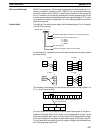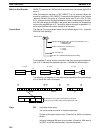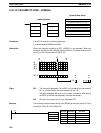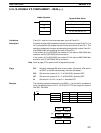
220
Limitations Di must be within the values given below.
All source words must be in the same data area.
Bytes in the source words must contain the ASCII code equivalent of hexadeci-
mal values, i.e., 30 to 39 (0 to 9), 41 to 46 (A to F), or 61 to 66 (a to f).
Description When the execution condition is OFF, HEX(––) is not executed. When the
execution condition is ON, HEX(––) converts the designated byte(s) of ASCII
code from the source word(s) into the hexadecimal equivalent and places it into
D.
Up to 4 ASCII codes may be converted beginning with the designated first byte
of S. The converted hexadecimal values are then placed in D in order from the
designated digit. The first byte (rightmost or leftmost 8 bits), the number of bytes
to be converted, and the digit of D to receive the first hexadecimal value are
designated in Di. If multiple bytes are designated, they will be converted in order
starting from the designated half of S and continuing to S+1 and S+2, if
necessary.
If more digits are designated than remain in D (counting from the designated first
digit), further digits will be used starting back at the beginning of D. Digits in D
that do not receive converted data will not be changed.
Digit Designator The digits of Di are set as shown below.
Specifies the first digit of D to be used (0 to 3).
Number of bytes to be converted (0 to 3)
0: 1 byte (2-digit ASCII code)
1: 2 bytes
2: 3 bytes
3: 4 bytes
First byte of S to be used.
0: Rightmost 8 bits (1
st
byte)
1: Leftmost 8 bits (2
nd
byte)
Parity 0: none
1: even
2: odd
Digit number: 3210
Data Conversion Section 5-18


















